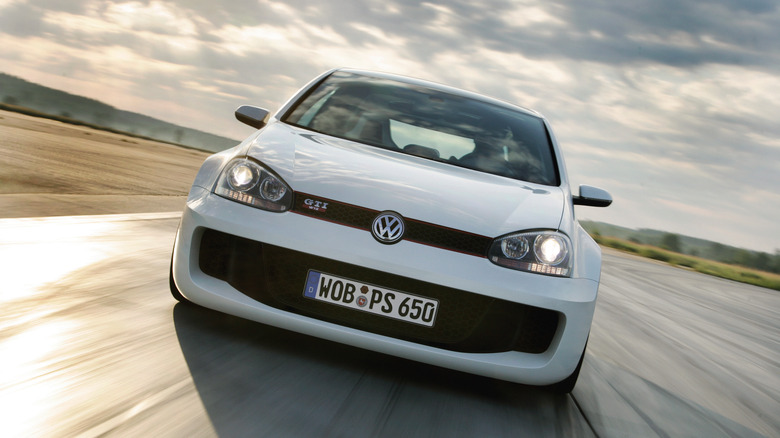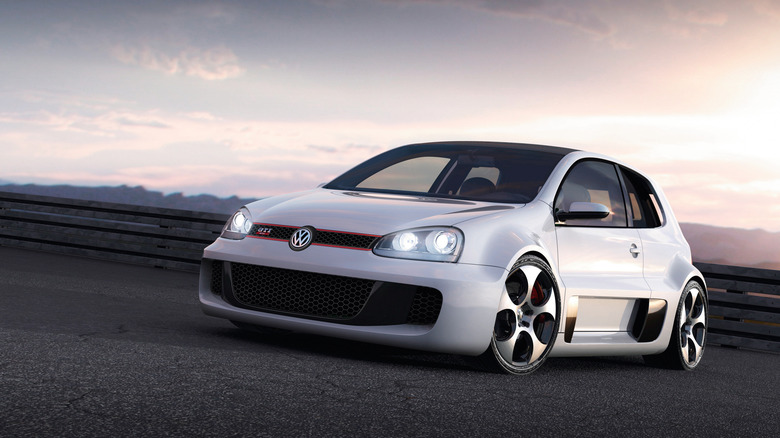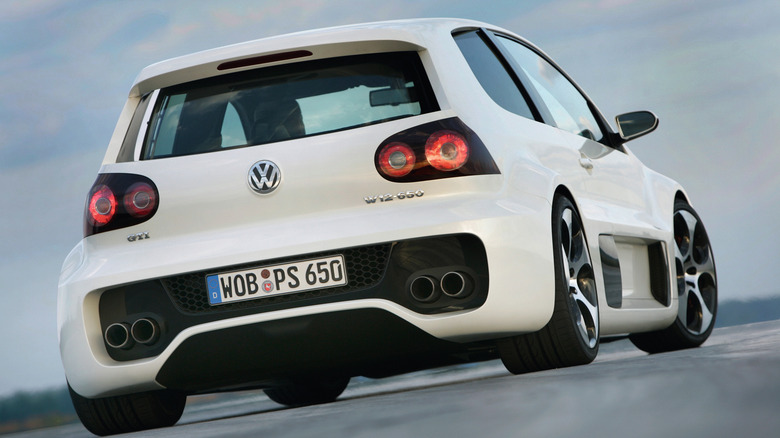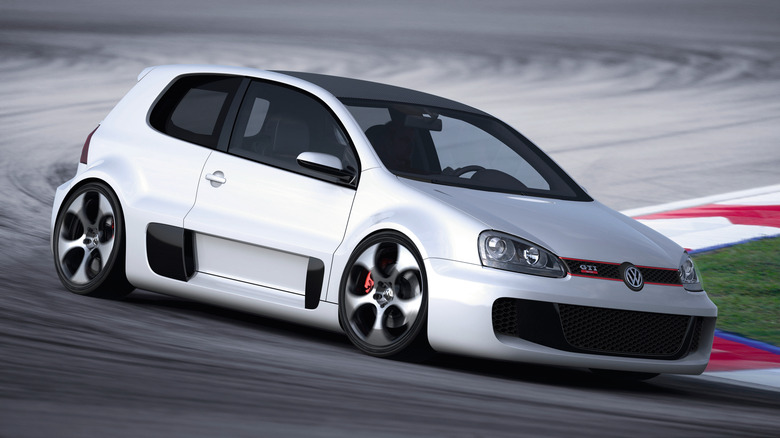Volkswagen's W12-Powered GTI: The Golf You Wish VW Had Sold
The Golf GTI is the classic symbol of hot hatchback. With humble beginnings as a two-door 110-hp hatch over 40 years ago, the Golf GTI became an absolute legend with several successful generations and countless variations and concepts. But let's talk about that one time when Volkswagen went absolutely bananas with it.
In 2007, Volkswagen set out to surprise a huge gathering of iconic Golf enthusiasts in Wörthersee, Austria. The small lake town had an annual event dedicated to the Golf GTI between 1982 and 2023 when it was discontinued. Instead of introducing just another upgraded version of the GTI, VW pulled the wraps off something truly extraordinary — the Golf GTI W12-650. Potentially approved by an eccentric executive, this one-of-a-kind Golf GTI concept featured a W12 engine with an output of a whopping 650 horses.
Putting a W12 engine in a Golf is akin to slotting a jet engine in a go-kart. The car packed so much power that the glove box was reserved for a fire extinguisher. And that's how Volkswagen pitched the wildest and wackiest version of the Golf GTI at Wörthersee Treffen. It's worth revisiting all the changes Volkswagen had to implement to a production-grade Golf to make this possible.
Body modifications to retrofit the W12 engine
Underneath the familiar cladding of the Golf, a remarkable transformation took place in the form of the W12 engine. It was a 6.0-liter, twin-turbocharged W12 engine, far superior to the standard turbocharged four-cylinder GTI engine. W12 engines, like this one, belong in supercars such the Bentley Continental GT and Audi R8. The unusual design comprises 12 cylinders in a peculiar orientation, featuring two narrow V6 engines angled at about 15 degrees.
As mentioned, the Golf GTI's engine delivered 650 hp — while the standard GTI churned out around 200 hp at the time — and 553 lb-ft of torque. To manage this formidable power, a six-speed automatic transmission was borrowed from the Volkswagen Phaeton limousine.
To house the massive engine, the body of the original Golf also underwent major modifications. The team adopted a mid-engine design, moving the engine behind the driver's seat. This transformation required significant reworking of the car's layout. The traditional Golf was widened by a substantial 6.3 inches to accommodate the necessary cooling vents for the mid-mounted engine and to allow for a wider track. This was accomplished by removing the rear seats and relocating the fuel tank to the front of the car. The GTI's C pillar was also redesigned to accommodate functional vents meant to direct airflow to the engine and, thus, meet its significantly large appetite for air. The engine delivered power to the rear axle, unlike the production model of the 2007 Golf GTI, which featured front-wheel drive.
Meticulous improvements to the GTI
Volkswagen made considerable effort optimizing the design, including both the interior and exterior of the W12 vehicle. The redesigned bumper had larger air intakes on the front and a prominent diffuser and large spoiler at the back. To cut back on the weight and add sportier aesthetics to the Golf GTI, Volkswagen recreated the roof with carbon fiber roof. For better grip on the racetrack (since the stated specifications were far from street legal), VW went with 19-inch alloy wheels wrapped in 295/30 ZR19 tires.
In addition to the supercharged engine and the improvised chassis, Volkswagen lowered the suspension system by about 2.75 inches to reduce drag at high speeds and improve the weight distribution with the mid-body engine. The creator were inspired by supercars to complement the heightened speed with equally capable braking power. The reimagined Golf GTI utilized 15-inch front disc brakes from the Audi RS4 and 14-inches discs from the Lamborghini Gallardo.
Besides exteriors, the interiors of the Golf GTI W12 were refashioned to add a sense of sportiness and luxury like the cars it borrowed its engine from. These modifications included a sporty bespoke instrument cluster with round gauges tailored to the W12-650's performance. The dashboard came with dedicated buttons for crucial features such as ESP, with transparent switch covers to prevent drivers from accidentally pressing them. Meanwhile, bucket seats wrapped in a premium black Alcántara upholstery exuded luxury.
Setting examples for hot hatchbacks
It's disappointing that Volkswagen introduced all these tweaks but did not disclose the performance numbers associated with them. According to some estimates, the mighty Golf GTI could zip from zero to 60 mph in less than 4 seconds and surpass the 201 mph mark. While these numbers present a very compelling image of the GTI W12's driving experience, experts who test-drove the car expressed concern. Tuning that kind of raw power for a production-ready vehicle would have taken more resources than Volkswagen would allocate — especially since it would forego the practicality, accessibility, and affordability of the actual Golf GTI. Even if Volkswagen underestimated the potential fan (or collectors) base for the Golf GTI W12, creating a street-legal version would have posed a monumental challenge.
Even though the W12 was a one-off creation, its spirit lives on in Golf's ever-evolving GTI lineup, which has amassed more power over the years. The current 2025 model, available in Europe, delivers 261 hp through its 2.0-liter turbocharged engine.
Perhaps one day we'll see another GTI concept as wild as the W12. Until then, it continues to serve as a benchmark for an untamed hot hatch and extends the realm to exotic concept cars such as Volkswagen's electric Golf GTI concept, aka the ID.GTI. But despite titillating successors, it will continue to that one special model of the Golf that enthusiasts wish they could buy.



